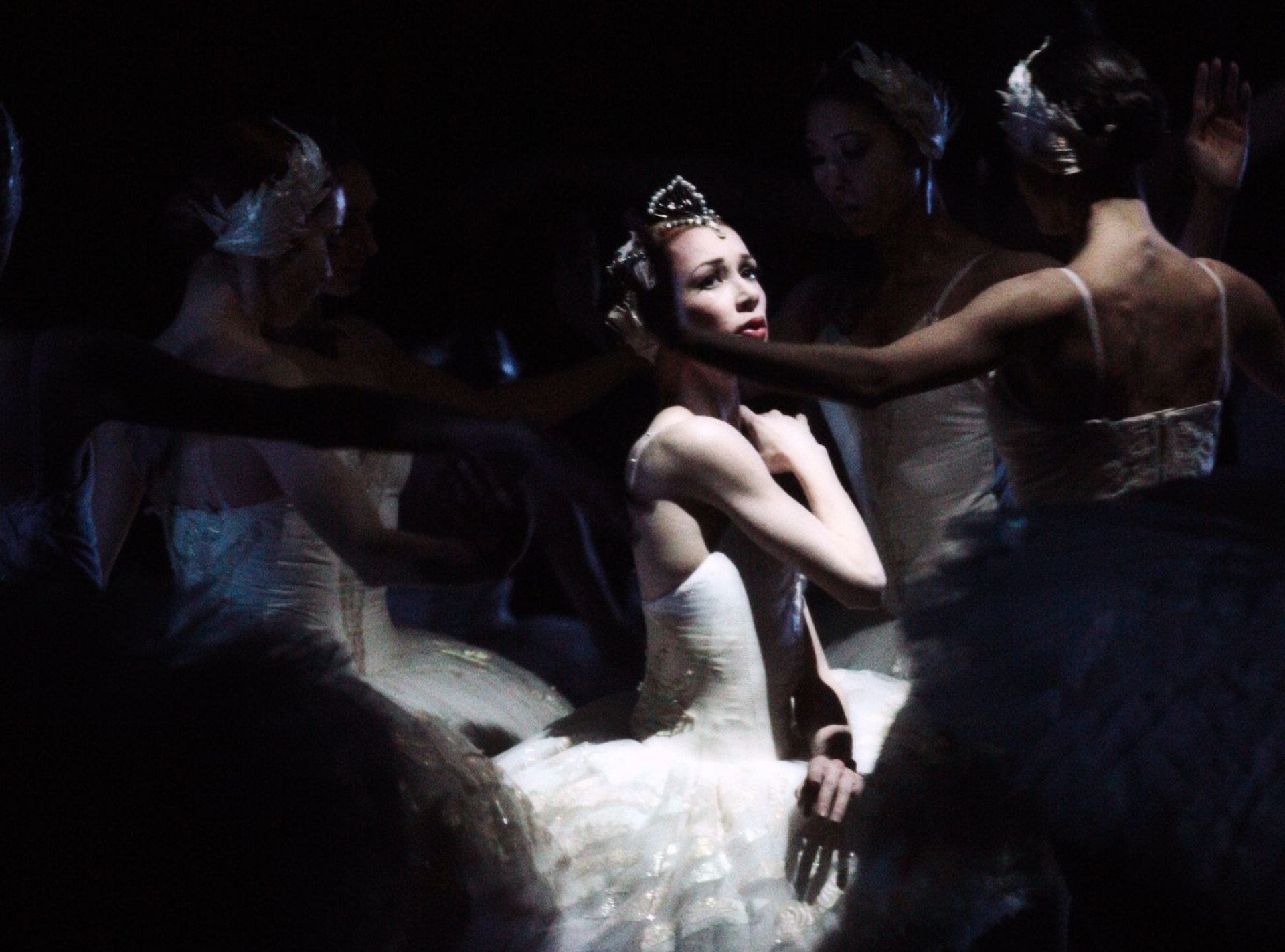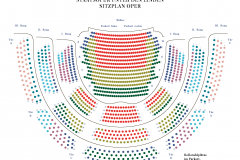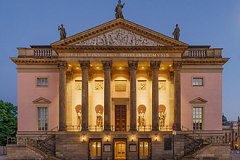Swan Lake
Mo | Tu | We | Th | Fr | Sa | Su |
Using the medium of classical dance, Swan Lake tells the story of Prince Siegfried and his love for the enchanted Princess Odette, who is trapped in the body of a swan. Alternating between swan and human, it is her destiny to be the object of the fantasies of the unhappy prince. In Patrice Bart’s interpretation, it is Siegfried’s mother who adores her son and holds all the threads of his fate in her hands. Without scruples, she manipulates his friend Benno and uses Prime Minister Rotbart as her accomplice. Drawing inspiration from the Romanov era in the Russian Tsarist Empire, this production is permeated by a haunting sense of decline, characterized by the unsettling combination of emotional coldness and decadence. The young prince finds refuge in his encounters with the swans. The captivating effect of these majestic birds is expressed in the large-scale swan images of the ballet, which are choreographically inspired by the archaic flight formations and their natural yet unreal beauty. With the dancers’ tutus resembling the white plumage of the birds, these imposing scenes have become synonymous with classical ballet. But Swan Lake has also become legendary because of the music by Peter I. Tchaikovsky, who imparts his unmistakable sound to the contrasting moods: whether it’s the longing that brings Prince Siegfried and Odette together or the deceptive splendour of the ball scenes, where the entire court falls under the spell of the seductive Odile. As Odette’s doppelgänger, she leads the prince to the tragic vow that betrays his sincere love.
Synopsis
Swan Lake is generally presented in either four acts, four scenes (primarily outside Russia and Eastern Europe) or three acts, four scenes (primarily in Russia and Eastern Europe). The biggest difference of productions all over the world is that the ending, originally tragic, is now sometimes altered to a happy ending.
Prologue
Some productions include a prologue that shows how Odette first meets Rothbart, who turns Odette into a swan.
Act 1
A magnificent park before a palace
[Scène: Allegro giusto] Prince Siegfried is celebrating his birthday with his tutor, friends, and peasants [Waltz]. The revelries are interrupted by his mother, the Queen [Scène: Allegro moderato], who is concerned about his carefree lifestyle. She tells him that he must choose a bride at the royal ball the following evening (some productions include the presentation of some possible candidates). He is upset that he cannot marry for love. His friend, Benno, and the tutor try to lift his troubled mood. As evening falls [Sujet], Benno sees a flock of swans flying overhead and suggests they go on a hunt [Finale I]. Siegfried and his friends take their crossbows and set off in pursuit of the swans.
Act 2
A lakeside clearing in a forest by the ruins of a chapel. A moonlit night.
Siegfried has become separated from his friends. He arrives at the lakeside clearing, just as a flock of swans land [Scène. Moderato]. He aims his crossbow [Scène. Allegro moderato], but freezes when one of them transforms into a beautiful maiden named Odette [Scène. Moderato]. At first, she is terrified of him. When he promises not to harm her, she explains that she and her companions are victims of a spell cast by the evil owl-like sorcerer named Rothbart. By day they are turned into swans and only at night, by the side of the enchanted lake – created from the tears of Odette's mother – do they return to human form. The spell can only be broken if one who has never loved before swears to love Odette forever. Rothbart suddenly appears [Scène. Allegro vivo]. Siegfried threatens to kill him but Odette intercedes – if he dies before the spell is broken, it can never be undone.
As Rothbart disappears, the swan maidens fill the clearing [Scène: Allegro, Moderato assai quasi andante]. Siegfried breaks his crossbow, and sets about winning Odette's trust as they fall in love. But as dawn arrives, the evil spell draws Odette and her companions back to the lake and they are turned into swans again.
Act 3
An opulent hall in the palace
Guests arrive at the palace for a costume ball. Six princesses are presented to the prince [Entrance of the Guests and Waltz], as candidates for marriage. Rothbart arrives in disguise [Scène: Allegro, Allegro giusto] with his daughter, Odile, who is transformed to look like Odette. Though the princesses try to attract Siegfried with their dances [Pas de six], he has eyes only for Odile. [Scène: Allegro, Tempo di valse, Allegro vivo] Odette appears at the castle window and attempts to warn him, but he does not see her. He then proclaims to the court that he will marry Odile before Rothbart shows him a magical vision of Odette. Grief-stricken and realizing his mistake (he vowed only to love Odette), he hurries back to the lake.
Act 4
By the lakeside
Odette is distraught. The swan maidens try to comfort her. Siegfried returns to the lake and makes a passionate apology. She forgives him, but his betrayal cannot be undone. Rather than remain a swan forever, she chooses to die. He chooses to die with her and they leap into the lake, where they will stay together forever. This breaks Rothbart's spell over the swan maidens, causing him to lose his power over them and he dies. In an apotheosis, they, who transform back into regular maidens, watch as Siegfried and Odette ascend into the Heavens together, forever united in love.
Program and cast
Duration: 02h 50m
Cast
Choreography And Staging: Patrice Bart
Music: Peter I. Tschaikowsky
Stage Design And Costumes: Luisa Spinatelli
Dramaturgy: Christiane Theobald
Musical Direction: Paul Connelly
Staatskapelle Berlin
State Opera Unter den Linden
Staatsoper Unter den Linden is one of Berlin's most prestigious opera houses, with a rich history and significant cultural impact.
History:
The Staatsoper Unter den Linden was originally built between 1741 and 1743, under the direction of architect Georg Wenzeslaus von Knobelsdorff. It was commissioned by Frederick II of Prussia and was initially named the Königliche Oper (Royal Opera). The opera house has undergone several renovations and reconstructions, notably after World War II damage. It reopened in 1984, following a major renovation.
Construction:
The original design was characterized by its Baroque style, featuring an elegant façade and a grand entrance. The building was reconstructed in the 1950s and 1980s, maintaining its classical exterior while modernizing the interior. The façade features a classic portico with six Corinthian columns and a prominent central pediment.
Interior:
The interior is known for its opulent and classical design. The auditorium is renowned for its acoustics and grandeur, with luxurious velvet seats and elaborate decorations. The stage and seating areas have been updated to meet modern performance standards while preserving historical aesthetics.
Concerts and Performances:
The Staatsoper Unter den Linden hosts a variety of performances, including operas, orchestral concerts, and ballet. It is home to the Staatskapelle Berlin, one of Germany's leading orchestras. The opera house is celebrated for its high-quality productions and its role in Berlin’s vibrant cultural scene.
JOURNEY
The Staatsoper Unter den Linden has completely barrier-free access due to its excellent public transport connections.
ADDRESS: Unter den Linden 7; 10117 Berlin
SUBURBAN RAILWAY
S+U Friedrichstraße (S1, S2, S5, S7, S25, S75)
SUBWAY
Hausvogteiplatz (U2)
Museumsinsel (U5)
Stadtmitte (U2, U6)
Unter den Linden (U5, U6)
BUS
Staatsoper (100, 245, 300)
Unter den Linden/Friedrichstraße (100, 147, 245, 300, N6)
PARKING
Q-PARK parking garage Unter den Linden/Staatsoper
Bebelplatz, 10117 Berlin
There are five electric charging stations in the parking garage. Further information can be found here.
The underground car park on Bebelplatz offers disabled parking spaces and direct access to the opera house. On entering the car park between 5.30pm and 11.30pm, the maximum parking fee is €7. To use this tariff, enter your parking ticket in one of the pay machines and the message »Theatertarif« will appear on the display. Please note that it is not possible to use the tariff if you enter the car park before 5.30pm. so it will not be shown on the display. TIP: If you pay the theatre tariff at the pay machine before the event, you can avoid unnecessary waiting after the show.

 EN
EN DE
DE IT
IT FR
FR ES
ES RU
RU JP
JP RO
RO
 Seating plan
Seating plan 